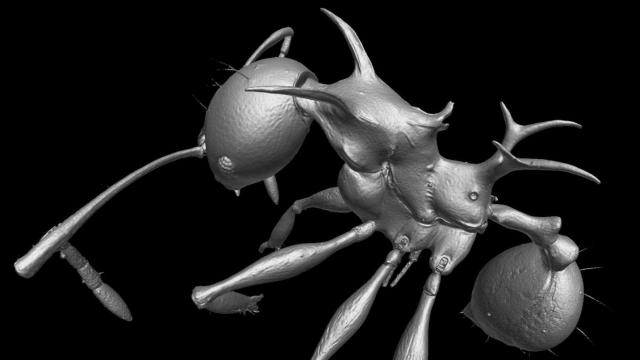While it can sometimes feel like we’ve turned over every last stone on this planet, it’s a fact that the natural world can still surprise us. Need some proof? Just feast your eyes on these badarse new dragon ants, discovered deep in the tropical rainforest of New Guinea.
Image: a new, highly adorned “dragon ant” discovered in New Guinea. Image: Sarnat et al. (2016)
Writing today in PLOS One, a team of entomologists at the Okinawa Institute of Science and Technology has just described two new species of Pheidole, the most diverse ant genus on Earth. The distinctive feature of the newcomers is a crop of fierce-looking spines jutting out of their dorsal plates. The scientists couldn’t help but notice how this spiky armour afforded their specimens a dragon-like appearance, which is why they judiciously tossed out traditional Latin naming conventions in favour of Pheidole viserion and Pheidole drogon.
Honestly, these ants look a bit scarier than Daenerys’s dragons on Game of Thrones.
Dispersed all over the world but concentrated in the wet tropics, the Pheidole genus includes over 1000 described species, and scientists suspect there are thousands more waiting to be identified. Despite this remarkable diversity, most of the species that have been studied are anatomically quite similar. In general, the Pheidole worker caste is split into two groups: Soldier ants, with comically enormous heads and powerful mandibles for milling up seeds, and “minor workers”, whose cranial features are less pronounced.
“Even though Pheidole vary in size quite a bit around the world, they more or less keep to the same body plan,” lead study author Eli Sarnat told Gizmodo. “Except for these crazy, spiny species.”
Found only in the Indo-Australian region, “spinescent” Pheidole are an evolutionary subplot in their own right. Sarnat estimates that over 100 species share the spiky armour, many of them distantly related. Intruiged that such a striking feature would evolve independently multiple times, Sarnat and his colleagues decided to round up the most armoured individuals they could find and given them a closer look using x-ray microtomography (micro-CT).
Not only did the analysis lead to the definitive identification of the two Targaryen namesakes, it yielded new clues about the function of the spines. While scientists previously assumed that Pheidole spines evolved for defence, micro-CT revealed that the soldier ants have exaggerated shoulder spines wrapped in a layer of muscle tissue. This extra musculature, the researchers say, suggests the spines could help support the ants’ humongous heads or power those crushing mandibles. “It’s still a hypothesis, and we still need to do more rigorous testing,” Sarnat said.
Whatever purpose that spiky armour does serve, the quest to discover it speaks to just how little we understand about the natural world we’re now erasing. Perhaps, by bringing more of nature’s overlooked wonders into the spotlight, scientists can remind the public that this planet, more than any fantasy world, is worthy of our admiration.
